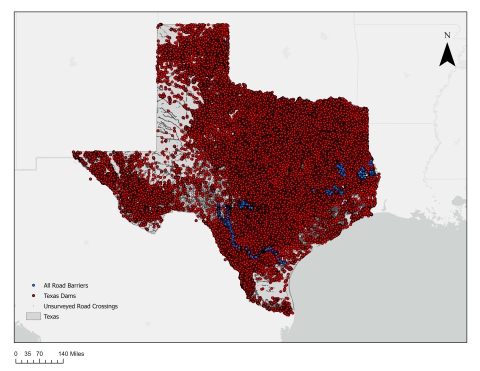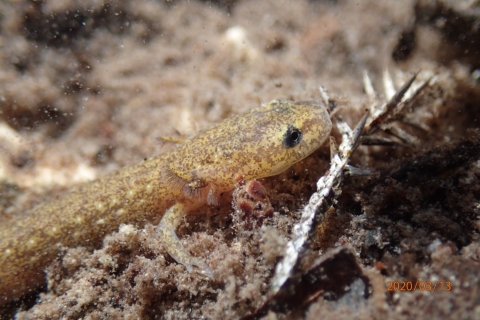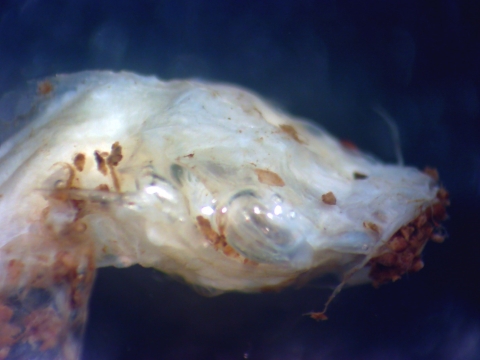What We Do
The Texas Fish and Wildlife Conservation Office promotes native self-sustaining ecosystems through leadership in fish restoration, fisheries research, monitoring, and non-native invasive species invasive species
An invasive species is any plant or animal that has spread or been introduced into a new area where they are, or could, cause harm to the environment, economy, or human, animal, or plant health. Their unwelcome presence can destroy ecosystems and cost millions of dollars.
Learn more about invasive species prevention. We assist managers in making sound decisions that build sustainable fisheries, recover endangered and threatened species, and maintain healthy ecosystems and habitats throughout Texas and the Gulf of America.
Management and Conservation
Through monitoring of endangered/ threatened or inter-jurisdictional species, the Texas Fish and Wildlife Conservation Office helps manage the resources of the American people and the State of Texas. Our office conducts habitat restoration and fish passage fish passage
Fish passage is the ability of fish or other aquatic species to move freely throughout their life to find food, reproduce, and complete their natural migration cycles. Millions of barriers to fish passage across the country are fragmenting habitat and leading to species declines. The U.S. Fish and Wildlife Service's National Fish Passage Program is working to reconnect watersheds to benefit both wildlife and people.
Learn more about fish passage projects through the National Fish Passage Program and the National Fish Habitat Partnerships.
Our Projects and Research
We use applied sciences and innovative technology to drive today’s management practices and enable the U.S Fish and Wildlife Service to work effectively with our partners to meet today’s complex conservation challenges.
Paddlefish Reintroduction
The Texas Fish and Wildlife Conservation Office partners with Tishomingo National Fish Hatchery, Texas Parks and Wildlife Department, The Caddo Lake Institute, and others to reintroduce paddlefish (Polyodon spathula), into the Big Cypress Bayou and Caddo Lake. Paddlefish were once numerous in the Big Cypress Bayou until the dam that formed Lake O’ the Pines was built in 1959, altering the natural flow pattern. The paddlefish population began to decline and was eventually lost from the watershed. As part of a larger environmental flows project, the paddlefish reintroduction tests the efficacy of the newly implemented environmental flow pattern and its effect on the environment downstream.
Bahia Grande Habitat Restoration Assessment
In 2000, Laguna Atascosa National Wildlife Refuge acquired the 21,700-acre Bahia Grande property, which had been dry for a period of 70 years. A cooperative partnership was formed to refill the basin and restore its original tidal processes. The Texas Fish and Wildlife Conservation Office and our partners from the Laguna Atascosa National Wildlife Refuge, Texas Parks and Wildlife Department, University of Texas Rio Grande Valley, and Inventory and Monitoring Program are conducting biannual fish monitoring on the Bahia Grande to assess the habitat restoration. Crews use bag seines and gill nets to sample size class, richness, distribution of species, and life stages of fish and invertebrates.
Phantom Cave Spring
Phantom Cave Spring is home to five endangered species: Comanche Springs pupfish (Cyprinodon elegans), Pecos gambusia (Gambusia nobilis), Phantom tryonia (Tryonia cheatumi), Phantom springsnail (Pyrgulopsis texana), and diminutive amphipod (Gammarus hyalelloides). Spring flow has been declining since the 1940’s and aquifer levels have dropped over 3.5 feet since 2000. Many restoration projects to secure the habitat have benefitted the spring and its inhabitants, but water levels continue to decline and imperil the species. Funded by a National Fish and Wildlife Foundation grant, the Fish and Wildlife Conservation Office, United States Bureau of Reclamamtion, and others are restoring the habitat by deepening the existing ciénegas (wetland system), so pumping is no longer needed.
National Fish Passage Program
National Fish Passage Program projects are funded and conducted each year in Texas. The U.S. Fish and Wildlife Service considers habitat fragmentation to be one of the biggest issues that impact fish and wildlife in the USA. The goal of the National Fish Passage Program is to restore native fishes and other aquatic species to self-sustaining levels by reconnecting habitat that has been fragmented by barriers. Our office is responsible for identifying and implementing fish passage fish passage
Fish passage is the ability of fish or other aquatic species to move freely throughout their life to find food, reproduce, and complete their natural migration cycles. Millions of barriers to fish passage across the country are fragmenting habitat and leading to species declines. The U.S. Fish and Wildlife Service's National Fish Passage Program is working to reconnect watersheds to benefit both wildlife and people.
Learn more about fish passage projects throughout the State of Texas.
National Fish Habitat Partnerships
The Texas Fish and Wildlife Conservation Office is responsible for implementation of the National Fish Habitat Partnerships projects in the State of Texas. The partnerships that include Texas are; the Southeast Aquatic Resources Partnership, the Desert Fish Habitat Partnership, and the Reservoir Fish Habitat Partnership. The mission of the National Fish Habitat Partnership is to protect, restore and enhance the nation's fish and aquatic communities through partnerships that foster fish habitat conservation and improve the quality of life for the American people.
American Eel Fish Passage
The Texas Fish and Wildlife Conservation Office has partnered with the Texas Coastal Ecological Service Field Office, Texas Parks and Wildlife Department, Louisiana Department of Wildlife and Fisheries, and the Sabine River Authority to conduct a five-year American eel (Anguilla rostrata) fish passage study at the Toledo Bend Dam on the Sabine River. The study was prompted by a Federal Energy Regulatory Commission relicensing agreement due to this site being a hydroelectric power dam. Methods include boat electrofishing, backpack electrofishing, and eel ramp traps. Results from this five-year study will determine if permanent fish passage structures are needed for American eel.
Dwarf Seahorse Distribution, Abundance, and Genetic Assessment
The Texas Fish and Wildlife Conservation Office has partnered with the University of Houston Clear Lake and the Southwestern Native Aquatic and Recovery Center’s Genetics Lab to study the dwarf seahorse (Hippocampus zosterae). The Dwarf Seahorse is a candidate species in the Gulf of America with an upcoming listing decision. The partnership received Section 6 funding to research the distribution, abundance, and genetic diversity of this species in Texas coastal waters. The study focuses on the seven major bay systems along the Texas Coast.
Coastal National Wildlife Refuges
The Texas Fish and Wildlife Conservation Office works with and offers aquatic assessments to our many coastal National Wildlife Refuges. Both Saltwater and freshwater fisheries management plans are developed to help refuges inventory and manage their aquatic environments for expansion of public fishing opportunities. Knowledge about coastal water bodies promotes better understanding of food resources availability to top priority migrating and wintering waterfowl. Coastal refuges also offer nursery habitat for many sport and commercial fish species that are economically and recreationally important to other agencies and the public.
Oysters and Red Drum in the Classroom
The Oysters and Red Drum in the classroom is a partnership between our office, the Galveston Bay Foundation and Texas Parks and Wildlife Department. The program provides curriculum, aquariums, Oysters (Crassostrea virginica), Red Drum (Scianops occelatus), and biologist support. The program encompasses multiple elementary through high school classes in the Houston-Galveston area. Students hold oysters and Red Drum in an aquarium for 2-3 months, learning how they play an important role in the estuary ecosystem. The goal is to foster a strong connection between young adults and the environment by exposing them to natural processes that occur in the bay.
Coastal Brigades
The Coastal Brigades is a leadership camp dedicated to exposing kids to coastal fisheries and encouraging stewardship of coastal natural resources. Campers learn about fisheries management, habitat, ecology, saltwater fishing, public speaking, leadership skills, and careers in the natural resources. The Texas Fish and Wildlife Conservation Office specifically assists with the fisheries sampling techniques in Galveston Bay, including: gill nets, bay trawls, oyster dredging, and seining. The conservation office also participates in a Q&A panel about career opportunities in the agency and natural resource management. Other agency representatives include Texas Parks and Wildlife Department, Texas A&M Agrilife extension, Coastal Conservation Association, Coastal Bend Bays and Estuaries Program.
Eurycea Project
The Texas Fish and Wildlife Conservation Office is providing data and maps of Eurycea species populations in the Texas hill country to address knowledge gaps for Species Status Assessments conducted by the Austin Ecological Services Field Office. Our office compiles distribution data, abundance estimates, and genetic sampling for both the Texas (Eurycea neotenes) and Cascade Caverns (Eurycea latitans) salamanders across their range for comparison to other estimates from similar listed species to the north. The genetics samples obtained from this study are used to provide clarity on the taxonomic relationship in the southeastern hill country salamanders and better understand the underlying population substructure.
Blind Catfish Project
The Texas Fish and Wildlife Conservation Office is providing data and genetic material from the widemouth blindcat (Satan eurystomus) and the toothless blindcat (Trogloglanis pattersoni) to address knowledge gaps for Species Status Assessments conducted by the Austin Ecological Services Field Office. Our office documents and preserves any detection of the two cave dwelling fishes known to inhabit the southern portion of the Edwards Aquifer at depths of over 400 meters. The conservation office has been successful in capturing two specimens of T. pattersoni.
Blind Diving Beetle Project
The Texas Fish and Wildlife Conservation Office is providing distributional data on the Edwards Aquifer diving beetle (Haideoporus texanus) within Hays and Comal counties to address knowledge gaps for the Twelve Month Finding conducted by the Austin Ecological Services Field Office. Specimens of other undescribed species from the Frio River (Real County), the Nueces River (Edwards County) and Robertson Springs (Bell County) are also to be included in the analysis.
Salado Salamander Monitoring
The Texas Fish and Wildlife Conservation Office has been monitoring the Salado salamander for six years at the Salado Downtown Spring Complex and at Robertson Springs in Bell County. Our office has collected data on population size and structure structure
Something temporarily or permanently constructed, built, or placed; and constructed of natural or manufactured parts including, but not limited to, a building, shed, cabin, porch, bridge, walkway, stair steps, sign, landing, platform, dock, rack, fence, telecommunication device, antennae, fish cleaning table, satellite dish/mount, or well head.
Learn more about structure , population genetics, habitat associations, geographic distribution, and the prey available within their distribution.





